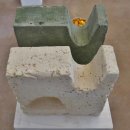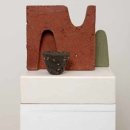The Angel's Share - current work
Work from The Angel's Share can be purchased or commissioned in particular colour ways. Commission information, samples, price list and commission lead times available on request
Fiona's free standing ceramic and crystocal plinth assemblages, go under the name The Angel’s Share, an industry term for the portion of whisky lost in evaporation in the cask barrel. Here however, the phrase is a metaphor for the poetics of the temporal "soul" as described by Gaston Bachelard. Fiona's work is innovative in the way it distils and reassembles architecture, painting and decorative art to this end. Thus the composition, colour and rhythm of the 3 dimensional assemblages are informed by early Italian Renaissance architecture and painting; namely Giotto di Bondone’s (d.1337), Scrovegni Chapel frescoes, (1303 - 1305) in Padua, Italy and Duccio di Buoninsegna’s (d.1319), Maesta,(1308 - 1311) commissioned by Siena Cathedral.
At the same time the Fiona's material process engages with modernism’s formalist legacy through the deconstruction of narrative into discrete components; visible process (press moulded clay, mono printing, collagraphy), the repetition of minimalist rectangles and colour, repetition also being integral to ceramic process. The slip cast interior of a Duchess amber ware teacup and textures adapted from embossed wall paper make allusion to design history, as does the juxtaposition of press moulded and slip cast ceramic. As with Joseph Cornell (d.1972), Fiona's poetics creates a disturbance of consciousness in the viewer. The viewer's origining imagination inhabits and reinvents the forms and processes, locating the angel’s share, within themselves.
Gaston Bachelard's book The Poetics of Space shows the soul is domestic. It likes a house and it daydreams in this cosy place. These daydreams share certain properties for the soul reflects on itself through form and image. In Fiona's assemblages, the rectangle is terrestial and the circle aerial. There is cosmic tension between the two. These forms may be present as themselves or embedded in motifs such as a shallow box, a recessed lair, a window, the slip cast interior of a tea cup. Repeating forms and the spaces in between are fixations in time as is the solitary compressing of clay. The windows, the recesses or lairs and the teacup interior are inversions of each other, of the soul's inner light. These singular forms are also huts, a core image of inhabiting, of dreaming solitude. Julia Kristeva's (b.1941) conception of "the semiotic, " an instinctual emotional field which dwells in the crevices and poetic rhythms of language, describes Fiona's material process. Her compressing of clay and colour is a truly primitive action of origin. Kristeva's perceptive essay, Giotto's Joy, notes how in infant development, colour perception precedes the mirror phase where the child develops a sense of self. Colour is, in Kristeva's words, "material substance." Fiona's coloured clay and Giotto’s coloured fresco is an integral aspect of the origining process. Material substance is unbounded time and space made visceral. This felicitous space is Giotto’s gift and Duccio di Buoninsegna’s legacy.
Fiona's free standing ceramic and crystocal plinth assemblages, go under the name The Angel’s Share, an industry term for the portion of whisky lost in evaporation in the cask barrel. Here however, the phrase is a metaphor for the poetics of the temporal "soul" as described by Gaston Bachelard. Fiona's work is innovative in the way it distils and reassembles architecture, painting and decorative art to this end. Thus the composition, colour and rhythm of the 3 dimensional assemblages are informed by early Italian Renaissance architecture and painting; namely Giotto di Bondone’s (d.1337), Scrovegni Chapel frescoes, (1303 - 1305) in Padua, Italy and Duccio di Buoninsegna’s (d.1319), Maesta,(1308 - 1311) commissioned by Siena Cathedral.
At the same time the Fiona's material process engages with modernism’s formalist legacy through the deconstruction of narrative into discrete components; visible process (press moulded clay, mono printing, collagraphy), the repetition of minimalist rectangles and colour, repetition also being integral to ceramic process. The slip cast interior of a Duchess amber ware teacup and textures adapted from embossed wall paper make allusion to design history, as does the juxtaposition of press moulded and slip cast ceramic. As with Joseph Cornell (d.1972), Fiona's poetics creates a disturbance of consciousness in the viewer. The viewer's origining imagination inhabits and reinvents the forms and processes, locating the angel’s share, within themselves.
Gaston Bachelard's book The Poetics of Space shows the soul is domestic. It likes a house and it daydreams in this cosy place. These daydreams share certain properties for the soul reflects on itself through form and image. In Fiona's assemblages, the rectangle is terrestial and the circle aerial. There is cosmic tension between the two. These forms may be present as themselves or embedded in motifs such as a shallow box, a recessed lair, a window, the slip cast interior of a tea cup. Repeating forms and the spaces in between are fixations in time as is the solitary compressing of clay. The windows, the recesses or lairs and the teacup interior are inversions of each other, of the soul's inner light. These singular forms are also huts, a core image of inhabiting, of dreaming solitude. Julia Kristeva's (b.1941) conception of "the semiotic, " an instinctual emotional field which dwells in the crevices and poetic rhythms of language, describes Fiona's material process. Her compressing of clay and colour is a truly primitive action of origin. Kristeva's perceptive essay, Giotto's Joy, notes how in infant development, colour perception precedes the mirror phase where the child develops a sense of self. Colour is, in Kristeva's words, "material substance." Fiona's coloured clay and Giotto’s coloured fresco is an integral aspect of the origining process. Material substance is unbounded time and space made visceral. This felicitous space is Giotto’s gift and Duccio di Buoninsegna’s legacy.

The Angel's Share, h: 76 cm, d: 35 cm, l: 110cm, stoneware, earthenware, porcelain

The Angel's Share side view

The Angel's Share (arena), h: 35cm, w: 25cm, d: 35cm

The Angel's Share, variation in green and gold, w:25cm, h: 25.5 cm, d:38cm

The Angel's Share, variation in gold and green aerial view

family of beakers

Blue Penninsula (After Joseph Cornell) , w 44cm x h 32cm x d 47 cm, stoneware, porcelain, crystocal base

Blue Penninsula (After Joseph Cornell) , view 2

Origin, (view 1)

Origin, ( view 2)

Hut (Joachim Dreaming)

Golden Gate (after Giotto) w: 25cm x h: 27cm x d: 25cm, stoneware, porcelain, crystocal base

Golden Gate (after Giotto detail ,obverse side)
